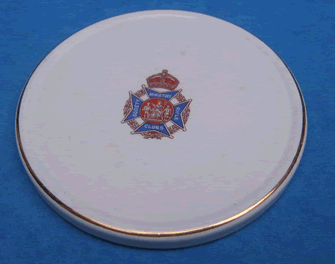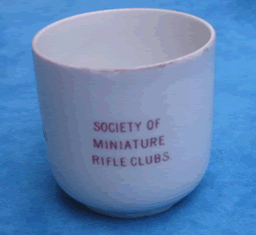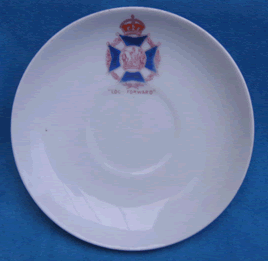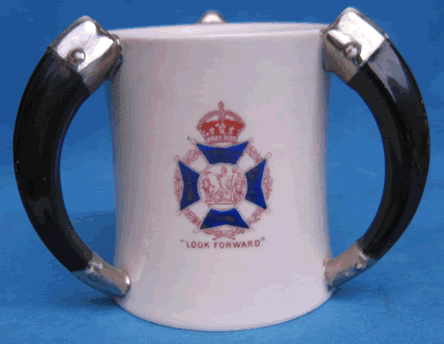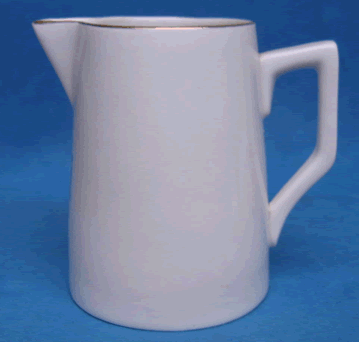SMRC PRIZE CROCKERY & SILVERWARE
CROCKERY ...........................................SILVERWARE
see also details of the current "SMRC" Historic Arms Matches held during the first week of the NSRA August Bisley National Rifle Meeting
The CHINAWARE
Below: as an introduction, we illustrate the current mug of the National Small-bore Rifle Association (NSRA).
Then follows a collection of the pre-1947 ceramic and silver prize items offered by the Society of Miniature Rifle Clubs.
These items were occasionally given as prizes at a meeting, or could be purchased, as a physical reminder of a competition success, on production of written evidence such as a prize certificate.
THE NSRA MUG
Manufactured by Valiant Heraldics Ltd., of Littlehampton, U.K.
The current NSRA motif remains the Maltese Cross containing Britannia and the pair of riflemen,
and the motto "Look Forward" is retained to this day..
The wording in each quarter of the cross has been amended, since 1947, to read
NATIONAL SMALL-BORE RIFLE ASSOCIATION rather than the original SOCIETY (of) MINIATURE RIFLE CLUBS
We show a selection of SMRC crockery, much of which carries no makers identification other than a pattern number.
Some larger items are marked, as shown alongside each, as being made by the Empire Works at Stoke-on-Trent.
Many of the pieces are manufactured to a quite basic specification and could, by today's standards, be described fairly as second quality.
WE START WITH THE LATER FOUR COLOUR TRANSFER PRINTED ITEMS
The first SMRC item: the round section teapot, in the rarer Ivory colour, and of rather indifferent quality.
Most SMRC ceramic products were white, but this cream coloured teapot is in the less common "Ivory" range.
with its separate stand
Next: the white oval section teapot with 'ruched' or 'scalloped' surround to the lid shelf, and of notably finer quality.
obverse of the oval teapot
The rectangular ashtray
The circular ashtray
The "Empire Works" maker's mark with the month (10) and year (29) of manufacture given at each end of the "ENGLAND" part of the stamp.
The celebration mug for the 1937 Coronation of King George VI
at the same time celebrating the Indoor Bisley meeting at Alexandra Palace
The later teacup and saucer
The sugar bowl
The cream jug
The coffee pot
The Tri-horn "Tyg" Cup
in its most common form
and the less common version presented for the Highest Match Score, with year designation.
The equally uncommonly found Salad Bowl
and in plan view
NEXT: THE EARLY CROCKERY DESIGN WITH SINGLE COLOUR TRANSFER PRINTING
The teacup and saucer showing the motif position
and the individual components
The plate
The sugar bowl
The cream jug
The larger serving or sandwich plate
and, finally, the standard sized egg cup
SHOULD YOU HAVE ANY SMRC SILVER OR CERAMICS NOT SHOWN ON THIS PAGE, THEN WE WOULD BE MOST GRATEFUL FOR PHOTOGRAPHS.
FULL ACKNOWLEDGEMENT WILL BE GIVEN
~~~~~~~~~
The BSA CUP
is a competition still run today by the NSRA and, whilst prizes were contributed by the BIRMINGHAM SMALL ARMS COMPANY, the event was still under the aegis of the SMRC
Two main ceramic prizes were on offer; one from the Royal Doulton factory and the other probably from the Langley Mill Pottery. These jugs are most attractive from either manufacturer, The Doulton "beakers", as they were usually called, were often fitted with a silver rim - much enhancing the design, which dates from prior to the First World War.
The Royal Doulton version, shown first below, probably dates to the late 1920s.
The Langley version, dated circa 1930 - 1931, is shown below.
The SILVERWARE
Firstly - and most often awarded as prizes from the 1920s on, four silver prize spoons.
Left, the 'Earl Roberts'; 2nd. left, the 'HPS' for a Highest Possible Score;
3rd. from left, the jam spoon; right, the ubiquitous SMRC prize spoon, to be found in either solid Sterling silver or Electro-plate.
Again, the three main spoons, and the box showing the SMRC address at Ludgate.
The prize set
One of the SMRC vesta designs, available in either sterling silver or plate (EPNS)
The small SMRC pewter tankard
and the silver plated mug
A rare SMRC sugar-sifter
......................
Ca. 1920, believed to have been won by Sgt. Organ of the Metropolitan Police.
By kind permission of Julie H.
A second style of sifter has been shown to us by a helpful contributor.
The bowl is nearly identical, but the stem head is less ornate.
A particularly relevant fact has been brought to light by the discovery of an S.M.R.C. sterling silver prize spoon which carries hallmarks including a date code letter " i " for 1926-27. This spoon is a Sheffield assayed piece, showing the crown of the reign of Edward VII, the lion passant and the makers mark "W.T." for Walter Trickett, one of the more famous silversmiths.
The spoon is illustrated below.
..................
.The hallmarks described are shown - right
.as is the 'Maltese Cross' motif within a laurel wreath .............
showing Britannia centred..................
with two rifleman stood beside her..............
and, bottom right,..................
.................. the "Look Forward" motto for the Society.....................................................................................
It is worth recording that the spoon was won by one David Bayne, a Scotsman from Cooper, in Fife. Bayne typified many of his generation with his involvement in the burgeoning sport of rifle shooting which, nationally encouraged and supported, proved its anticipated worth only a dozen years later. He volunteered for service in the British Army on the 8th. of September 1914, barely six weeks after the declaration of war on Germany. Bayne served as a private in the 10th. Battalion of the Argyle and Sutherland Highlanders. He unsurprisingly qualified as a Marksman and, reported as having become a sharp-shooter, more commonly known as a sniper, he was fortunate enough to survive the conflict, and be demobbed, one hopes back into his pre-war employment as a draughtsman, late in April 1919.
SHOULD YOU HAVE ANY SMRC SILVER OR CERAMICS NOT SHOWN
PLEASE LET US KNOW OF IT.
FULL ACKNOWLEDGEMENT WILL BE GIVEN
Return to: TOP of PAGE
See this website's Raison d'être



